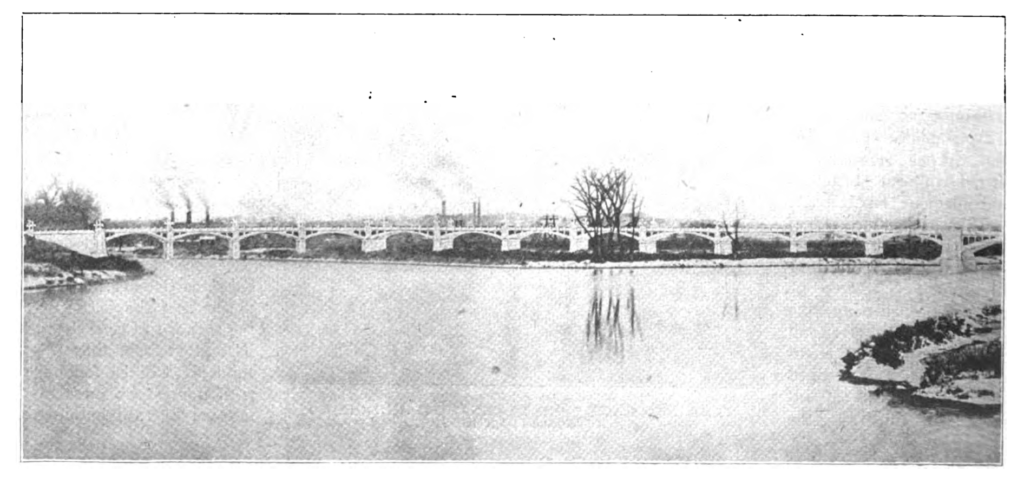“Successful Methods,” a civil engineering magazine from around about a century ago, took the time in November 1920 to detail how work on the Great Western Gateway Bridge was progressing:

A FOUR CONTRACT JOB
Work on Great Western Gateway at Schenectady, N.Y., is Divided Into Four Units
Work is well under way on the job of building the reinforced concrete abutments and approaches at the Schenectady and Scotia ends of the Great Western Gateway in New York State. The bridge which will carry the main State highway between the East and West over the Mohawk River and Barge Canal channel, is shown in the engineer’s drawing at the bottom of this and the opposite pages.
The equipment for this job consists of a pile driver and derrick for placing the pedestal piles, an excavating machine, used in digging the trench for the reinforced concrete approach walls, two concrete mixers and a variety of other items, including a cofferdam. This is just the beginning of work that will ultimately involve the use of many additional items of equipment and will call upon contractors for some thoroughly modern methods and some big work.

The structure, which has been planned and designed by State Engineer Frank M. Williams of New York, is to be built of reinforced concrete and, aside from the fact that it will serve as the roadway over which most of the automobile traffic between the East and West is to pass, it will have the distinction of being one of the nation’s most beautiful parkways.
The Great Western Gateway derives its name from the fact that Schenectady is located at the point in New York where there is a natural break in the great Appalachian Mountain chain extending along our eastern coast. It was through this gape or gateway that the early settlers made their way westward and it was this same breach that made the construction of the Erie Canal a possibility.
The new structure will extend from the intersection of State Street and Washington Avenue, Schenectady, to the approximate center of Mohawk Avenue in the village of Scotia thereby leading directly to the State road to Buffalo. The bridge will be 4,436 feet in length and the Schenectady approach will be provided with a raised safety zone which will serve as a regulator of traffic. A 40 ft. roadway will span the new Barge Canal Terminal Basin, Van Slyke Island, Barge Canal, Hog Island and Mohawk River. This road will end in a circular traffic center.
Under the plans decided upon by Mr. Williams the structure will represent an expenditure of approximately $2,000,000 of which amount the City of Schenectady has contributed $100,000 and the village of Scotia $50,000. The structure is to be erected by the contract method but differs from others in that, instead of being let in a single contract, the work has been split up into four parts. Each part will cover a different phase of the work and the four units are to be awarded at different times, the intention being to so coordinate the work that as one contract nears completion the other can get under way.
The first contract covers only the construction of the approaches and abutments at each end of the structure. The second contract calls for the construction of 23 reinforced concrete piers. Provision is made in this, however, for the construction of piers 1 to 4 and 19 to 20 inclusive by December 31, 1920 and the completion of all the piers by December 31, 1921. Under this plan the piers at the east and west ends of the structure will be completed first, thereby enabling the contractor who obtains the third contract, calling for the erection of the reinforced concrete arches and superstructure, to start work at both ends of the bridge early next spring. In the meantime the fourth and last contract which calls for the paving and lighting work will have been advertised, so that as the third contract progresses the work of paving the roadway can be undertaken.
This plan, it is confidently expected will see the structure well under way next summer and early in 1922 the bridge will be opened to traffic. A feature of the bridge is the 212 foot span over the Barge Canal channel.
The important part which the Great Western Gateway is to take in the development of automobile and commercial traffic in the State of New York may be judged by the fact that the old toll bridge now spanning the Mohawk River at this point, collects toll from an average of 1,000 automobiles daily while numerical count shows that 22,000 people cross the bridge every 24 hours.
Ultimately, of course, the bridge didn’t open until nearly four years later than scheduled, at the very end of 1925 (and that lateness could be the explanation for a December celebration).

